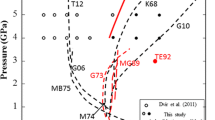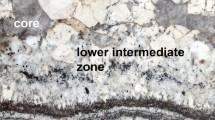Abstract.
Cooling rates inferred from water speciation in rhyolitic glass inclusions in quartz phenocrysts from the Bishop Tuff, California, vary over more than 5 orders of magnitude from about 10 to <10–4 °C s–1. Many of the cooling rates are within the previously published, experimentally calibrated range of this technique but the slowest rates (<10–4 °C s–1) are extrapolated. Such extrapolation suggests cooling rates as low as 10–8 °C s–1 (0.3 °C year–1) for the interiors of thick, pyroclastic-flow deposits. The temperatures at which OH and molecular H2O species would be in equilibrium range from ~400 °C for glass inclusions from Plinian-fall deposits to ~250 °C for the most slowly cooled glassy inclusions from pyroclastic-flow deposits. Notwithstanding appreciable uncertainties, cooling rates correlate with depositional process (fall vs. flow deposition) and distance above the cold ground or below overlying, hot pyroclastic-flow deposits. Plinian inclusions within 2.5 m of the cold, pre-Bishop ground cooled at 1–10 °C s–1, consistent with thermal modeling of small pumice clasts falling through cold air. Very slow, inferred cooling rates for pyroclastic-flow deposits (~10–6 to 10–8 °C s–1) also agree with thermal-conduction models. Faster cooling rates (~10–1 to 10–4 °C s–1) for inclusions in the lowermost 0.5 m of pyroclastic-flow deposits reflect the effect of quenching against the cold ground. At Blind Spring Hill (east of Long Valley Caldera), intermediate cooling rates (10–3 to 10–6 °C s–1) are observed in Plinian deposits overlain by, and partially interbedded with, pyroclastic-flow deposits, indicating that reheating of rapidly cooled Plinian inclusions can reset water speciation. Melt inclusions in pyroclastic-flow deposits are quenched to glass only if the deposit is relatively thin or has a relatively low emplacement temperature. In relatively thick or hot deposits, inclusions may be quenched to glass at the base of the deposit where it is more rapidly cooled by contact with the pre-eruption ground.
Similar content being viewed by others
Author information
Authors and Affiliations
Additional information
Electronic Publication
Rights and permissions
About this article
Cite this article
Wallace, P.J., Dufek, J., Anderson, A.T. et al. Cooling rates of Plinian-fall and pyroclastic-flow deposits in the Bishop Tuff: inferences from water speciation in quartz-hosted glass inclusions. Bull Volcanol 65, 105–123 (2003). https://doi.org/10.1007/s00445-002-0247-9
Received:
Accepted:
Published:
Issue Date:
DOI: https://doi.org/10.1007/s00445-002-0247-9




